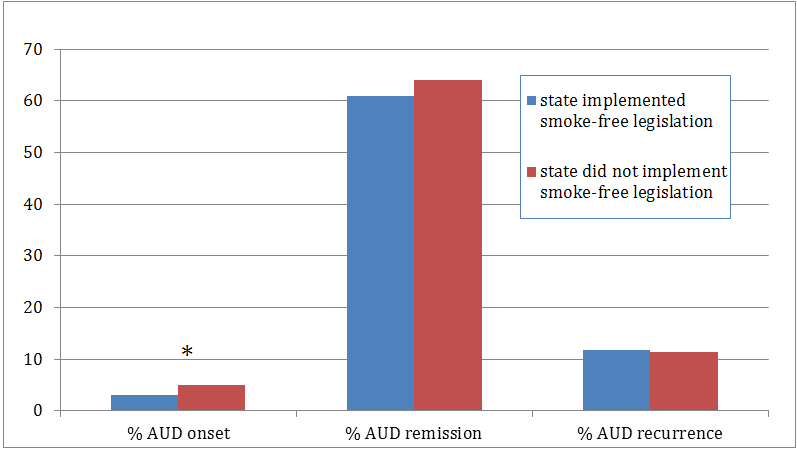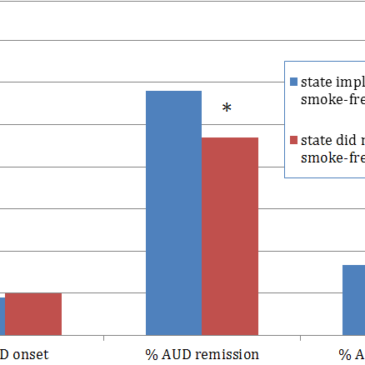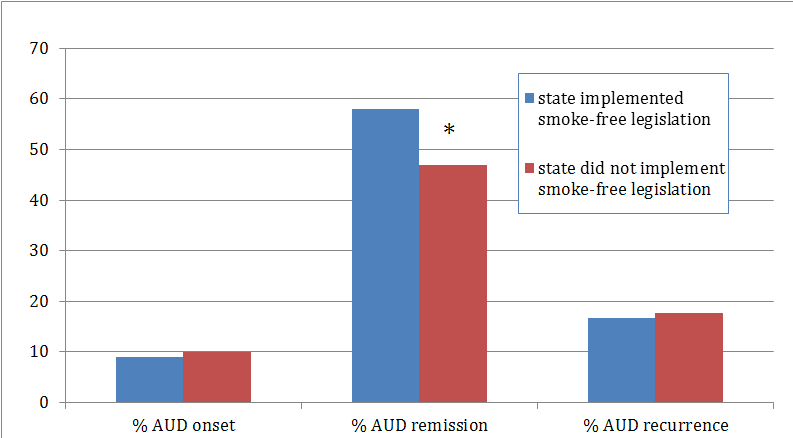Many studies have demonstrated the effectiveness of anti-smoking legislation on reducing smoking (e.g., see ASHES 9(5)). Given the high comorbidity of alcohol abuse and smoking, it is possible that smoke-free policies, such as smoke-free public places, also reduce alcohol use. This week’s DRAM reviews a study that investigated if smoking prohibition in bars and restaurants impacts incidence and remission of alcohol use disorder (Young-Wolffa, Hylandb, Desaia, Sindelara, Pilvera, &. McKeea, 2013).
Methods
- Researchers used data from the National Epidemiologic Survey on Alcohol and Related Conditions (NESARC, 2006), a longitudinal, nationally representative study.
- The study included data from 2 waves: 2001-2002 and 2004-2005.
- Participants were 19,763 residents of the 41 US states without smoke-free legislation at wave 1 who reported any alcohol use at wave 1.
- Researchers identified states that implemented the smoke-free policies between wave 1 and 2 and those that did not.
- NESARC used the Alcohol Use Disorder and Associated Disabilities Interview Schedule (AUDADIS-IV; Grant et al. 2003) to assess past-year DSM criteria for alcohol use disorders, as well as other disorders not reported here. The AUDADIS-IV also asked about drinking and smoking behaviors.
- Researchers included only participants who could be defined using the three transition categories:
- Alcohol Use Disorder (AUD) remission: participants (N = 2,434) who had AUD at wave 1, but no AUD at wave 2.
- AUD onset: participants (N = 12,468) who had no past or current AUD at wave 1, but had AUD at wave 2.
- AUD recurrence: participants (N = 4,861) who had past but no current AUD at wave 1 and a current AUD at wave 2.
Results
- Figures 1a and 1b, below, show the percentage of respondents falling into each of the three transition categories defined above, grouped by gender and whether their state of residence implemented smoke-free legislation between wave 1 and wave 2 of the study.
- Introducing smoke-free legislation was positively related to AUD remission among men (odds ratio [OR] = 1.62) (Figure 1a).
- Introducing smoke-free legislation was negatively associated with AUD onset among women (OR = .68) (Figure 1b)
- Likelihood of recurrence was not associated with smoke-free legislation either for men or women.
Figure 1а. Rates of AUD onset, remission, and recurrence among men. Note: these figures include residents of states without smoke-free legislation at wave 1 who reported any alcohol use during wave 1. *Odds ratio significantly different from 1 – percent differs by smoke-free legislation status. Click image to enlarge.

Figure 1b. Rates of AUD onset, remission, and recurrence among women. Note: these figures include residents of states without smoke-free legislation at wave 1 who reported any alcohol use during wave 1. *Odds ratio significantly different from 1 – percent differs by smoke-free legislation status. Click image to enlarge.
Limitations
- The relationships between smoking bans and AUD onset and remission do not establish causality. More evidence is needed before we can conclude that living in states that enact smoking-free policies has an impact on AUD.
- The results are based on self-reported signs and symptoms of AUD and thus might be affected by self-report biases.
- It is possible that some participants moved from state to state between wave 1 and 2. It may be that some of them moved because the smoke-free legislation was implemented (or not implemented) by these states. This might affect the results by adding a confound variable.
Discussion
The results of this study are mixed with regard to the effect of smoking legislation on alcohol abuse. Overall, smoking-free legislation appears to be associated with some aspects of alcohol use disorders. However, this effect varies for men versus women. For example, implementing smoking-free legislation is associated with reduced percentage of alcohol use disorders onset, but only among women. At the same time, implementing smoking-free legislation is correlated with higher percentage of AUD remission, but only among men. Future studies might investigate the source of these gender differences.
-Julia Braverman
What do you think? Please use the comment link below to provide feedback on this article.
References
Kelly C.Young-Wolffa, Andrew J.Hylandb, Rani Desaia, Jody Sindelara, Corey E. Pilvera, & Sherry A. McKeea (2013) Smoke-free policies in drinking venues predict transitions in alcohol use disorders in a longitudinal U.S. sample. Drug and Alcohol Dependence, 128, 214 -221.
National Epidemiologic Survey on Alcohol and Related Conditions. (2006). Alcohol Alert Number 70. 2013
Grant, B. F., Dawson, D. A., Stinson, F. S., Chou, P. S., Kay, W., & Pickering, R. (2003). The Alcohol Use Disorder and Associated Disabilities Interview Schedule-IV (AUDADIS-IV): reliability of alcohol consumption, tobacco use, family history of depression and psychiatric diagnostic modules in a general population sample.Drug and Alcohol Dependence, 71(1), 7-16.





